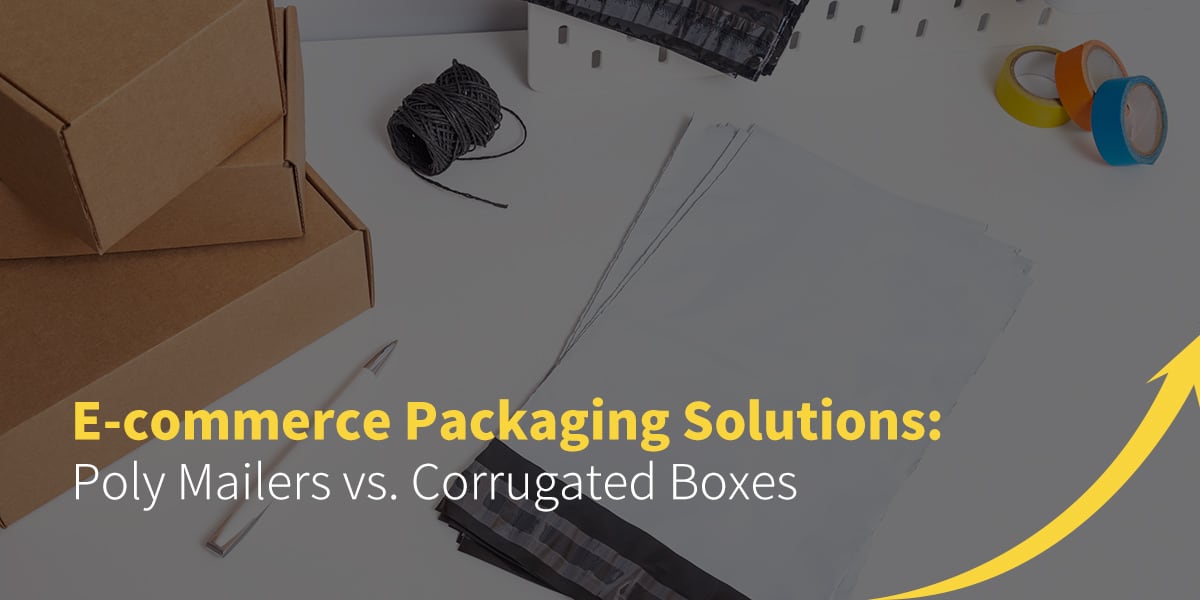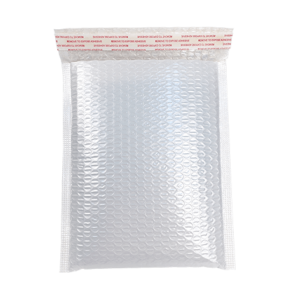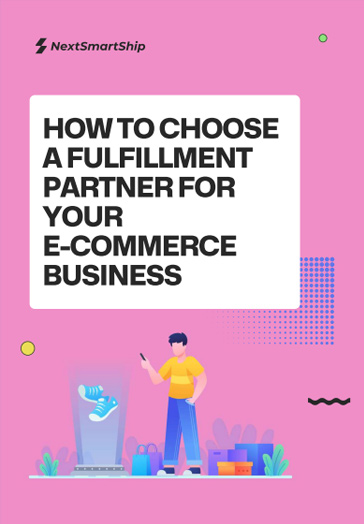Both mailers and boxes are excellent choices for shipping products; they reliable and affordable. However, they have different strengths and limitations, which means one may work better than the other in a specific situation. If you’re questioning which one is better for your business and products, this guide will help you decide.

Poly mailers
Poly mailers are light, cheap packaging materials, also referred to as plastic bags, poly bags, or plastic mailing bags.
They are malleable, self-closing polyethylene envelopes best suited for packaging non-fragile items such as clothes.
There 3 types of poly mailers:
Normal poly mailers
These are the most basic of all mailers. They are plastic bags that will hold anything from books and magazines to trousers and shirts. They offer minimal protection, but that won’t be a problem if your merchandise doesn’t need extra layers of cushioning. You can easily stick any stamps and labels onto them, and they are easy to seal.
Depending on their size, normal poly mailers weigh between 0.03 and 0.4 ounces when empty.
Bubble lined poly mailers.

Bubble-lined poly mailers improve on ordinary mailers by including a unique interior cushioned by bubble wrap. They are suitable for products that do not require standard packaging such as a box but still need protection. Bubble lined poly mailers are best suited for shipping small delicate items at low cost, and they are typically used to deliver fragile books, jewelry items, and small electronic devices. Like normal poly mailers, they are usually self-sealing.
On average, a bubble poly mailer weighs 1 ounce when empty.
Kraft mailers
Kraft mailers are composed of Kraft paper that is supple enough to carry several kinds of products. They are suitable for delivering soft items or anything that does not need rigid support during transit. They are sealed with an in-built peel-and-steel flap.
Depending on their size, Kraft mailers weigh between 1.2 and 1.8 ounces.
Why use poly mailers?
Low cost
Poly mailers are an inexpensive way to deliver products. They reduce the need for void fill and dunnage, thereby achieving material and cost savings
Productivity
Mailers minimize the need for labor and increase productivity. While other packaging materials involve complex operations, poly mailers require a two-step packaging process – packing the item and sealing it. This saves time and increases volume output.
Moisture resistance
Poly mailers are waterproof. Their ability to resist moisture helps prevent product damage.
Adhesive strength
Poly mailers come with a sturdy self-sealing adhesive. It will help you secure products during transit by ensuring nothing falls out. Some mailers are also tamper-resistant, which means that they cannot be opened and resealed without raising suspicion.
Air cushioning
Bubble lined poly mailers will protect fragile products from impact damage. This makes them ideal for glass items and other materials susceptible to scratching or cracking.
Low environmental impact
Poly mailers are easy to recycle and are often made from discarded plastic. They can also be designed to be reusable. These features limit their impact on the environment.
Compactness
Empty mailers are flat and light-weight, so they take minimal storage space. They also take minimal material to produce.
Corrugated boxes
Corrugated boxes are composed of ridged paper that contains multiple air columns. The columns increase the paper’s strength beyond that of average cardboard and provide an air cushion for any items within. The ridges offer flexibility and strength. The card boxes are environmentally friendly because they are biodegradable and recyclable.
Why use cardboard boxes?
Strength
Corrugated boxes are sturdier than typical cardboard. They will provide a firm padding for any product they carry during handling and shipping. They are also designed to prevent bacteria and moisture from contaminating the products inside, and this is especially vital for food items that must endure lengthy shipping times.
Custom
Corrugated boxes are easy to modify. You can ask your manufacturer to design special boxes that conform to the requirements of your business.
Custom branding
You can add branding messages to your corrugated packing material to enhance your brand and increase brand awareness.
Environmentally friendly
Corrugated boxes are made from 70-100% recycled material. This makes it one of the most environmentally friendly packaging materials ever created. Corrugated boxes can be easily re-purposed, recycled, or disposed of.
Pros and cons side by side comparison
| Poly mailers | Corrugated boxes | ||
| Pros | Cons | Pros | Cons |
| light-weight | Easily punctured | Strong and sturdy | More expensive than poly mailers |
| Inexpensive | Handle only one item a time | Can hold heavy items | Higher shipping costs than mailers |
| Compact(take up little space | May be crushed between larger packages | May be custom designed | Often require padding materials |
| Simple packaging process |
Packaging fillers for corrugated boxes and poly mailers
Packaging fillers are materials that are put into a shipping package to provide protection from drops by eliminating empty space.
The best packaging fillers prevent damage during transit, such as scratches and breakage from being jostled around in a delivery truck, or being thrown around by a lazy delivery person. Products with pointed corners will quickly pierce the most durable corrugated box and tear through the toughest poly mailer. Adding wrapping or an extra layer of void filler will reduce the chances that such incidents will occur.
It is common to believe that you only need to use packaging fillers on delicate items. However, to maximize the visual appeal of your product to your client, you should always add them to your packaging.
Types of package fillers
Packaging paper
Packaging paper is a versatile item. It is a fine Kraft paper that you can fold to protect an item or crumple to use as cushioning. Packaging paper is ideal for adding a minimalist quality to durable items like books, lingerie, and other clothing.
Shredded cardboard
Shredded cardboard is a form of recycled packaging made from cardboard. It is usually obtained from cardboard that is no longer usable and can be cut down and converted back to paper pulp multiple times. It is particularly useful for protecting small but heavy items
Bubble wrap
Bubble wrap is an internal liner suitable for both corrugated boxes and poly mailers. It provides air cushions that prevent scratching and breakage, and its ideal for brands on a budget.
Air pillows
Air pillows are plastic bags filled with air. They provide better cushioning than bubble wrap, and they are ideal for high-volume warehouses. Furthermore, unlike paper fillers and bubble wrap, air pillows lock the product in place, so there are limited risks that it will be damaged. They are cheap and light, but they will increase the packaging volume, so they are not a good choice when your product is already very big. You can use bubble wrap instead.
Custom printing solutions
Printed poly mailers are custom made to incorporate branding messages, images, and colors. They are ideal for marketing your brand. An attractive, custom-designed polybag will be seen by anyone who handles the package, including delivery couriers, postal workers, and others.
Printed corrugated boxes
Like printed poly mailers, printed corrugated boxes display custom brandings such as logos and branding messages. They offer a low-cost opportunity to put your brand in front of several people who may not have any other chance to interact with your brand.
Custom corrugated boxes
Custom corrugation can dramatically minimize the amount of packing material needed to secure your products during shipping and reduce shipping costs. Depending on your product’s durability, you can design the internal space to permit a specific number of bubble wrap layers. This will help you avoid wastage.
Packing advice: how to choose between boxes and poly mailers
Pillows and other puffy low-value products: use a poly mailer and extract all the air to reduce the package’s volume.
Leather handbags and similar high-value branded products: Use printed corrugated boxes to reflect the quality of your brand.
Glass vases and other fragile, low-value products: use corrugated boxes lined with air pillows and bubble wrap. The corrugated boxes keep the products from being crushed by external weights, and the bubble wrap/air pillows prevent impact damage if the product is dropped or jostled around in transit.
Wool Panama hat (easily deformed products): use corrugated boxes with interior cardboard. The cardboard boxes protect the products from being crumpled by external forces.
Plastic action figures (high value, irregular-shaped products): use corrugated boxes with custom shaped plastic. The plastic encloses the products and keeps them from bouncing against each other. This prevents scratches and breakage during shipping.
Corrugated boxes will always be an ideal choice if your products fit, and they are sufficiently protected. That said, poly mailers are a great option too if you do not need lots of shipping space. Both materials have their strengths and drawbacks, so you’ll have to decide which suits your needs better. With either option, you will have plenty of sizes and styles to suit your needs.



